The Economics and Statistics Division maintains archives of previous publications for accountability purposes, but makes no updates to keep these documents current with the latest data revisions from Statistics Canada. As a result, information in older documents may not be accurate. Please exercise caution when referring to older documents. For the latest information and historical data, please contact the individual listed to the right.
<--- Return to Archive
For additional information relating to this article, please contact:
October 05, 2018US EMPLOYMENT, SEPTEMBER 2018 The US Bureau of Labor Statistics reports today that US non-farm payroll employment increased by 134,000 in September. Results for August were revised to show a much stronger gain of 270,000 while July employment results were revised up to a gain of 165,000. After a strong month in August, US employment growth is slower in September compared to the average pace set over the previous 12 months.
US employment gains in August were reported for the following sectors: professional/business services (+54,000), health care (+26,000), transportation and warehousing (+24,000), construction (+23,000), manufacturing (+18,000) and mining (+6,000). There was little change in the other major sectors of the economy: wholesale and retail trade, information, finance, and government. Employment in leisure and hospitality was little changed, though some of the weakness seen in September may reflect the impact of Hurricane Florence.

The US unemployment rate declined to 3.7 per cent in September from 3.9 in August. Unemployment rates across most advanced economies (including Canada and Nova Scotia) are declining to levels below long run averages.

The US participation rate was steady at 62.7 per cent in September. Unlike unemployment rates, the US participation rate has failed to return to pre-recession levels and has only increased modestly since bottoming out in 2015, with fluctuations around a narrow range since the start of 2016.
Participation rates in Canada and Nova Scotia also declined in the years after the global financial crises, but Nova Scotia's participation rates have rebounded in the past few months.

The US employment to population ratio edged up to 60.4 in September. The US employment rate has maintained a very gradual upward trend since the middle of 2013.
Employment rates in Canada trended up in 2016 and 2017, but remained below levels observed in 2008. In September the employment rate edged up to 61.5 per cent in Canada. With an aging population and declining labour supply, Nova Scotia's employment rates have trended down since 2012. There has been some recovery in recent months, leaving the Nova Scotia employment rate at 57.0 per cent in September.

Note: Canadian and US labour force statistics refer to different working-age cohorts.
Source: US Bureau of Labor Statistics, Statistics Canada Table 14-10-0287-02
<--- Return to Archive